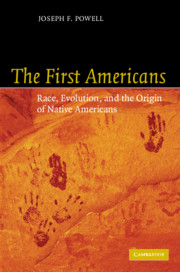Book contents
- Frontmatter
- Contents
- Acknowledgments
- Prologue: The Kennewick controversy
- PART I Race and variation
- 1 Debating the origins of Native Americans
- 2 A brief history of race
- 3 Evolutionary approaches to human variation
- 4 Recent population variation in the Americas
- PART II The Pleistocene peopling of the Americas
- PART III The First Americans, race and evolution
- References
- Index
2 - A brief history of race
Published online by Cambridge University Press: 21 August 2009
- Frontmatter
- Contents
- Acknowledgments
- Prologue: The Kennewick controversy
- PART I Race and variation
- 1 Debating the origins of Native Americans
- 2 A brief history of race
- 3 Evolutionary approaches to human variation
- 4 Recent population variation in the Americas
- PART II The Pleistocene peopling of the Americas
- PART III The First Americans, race and evolution
- References
- Index
Summary
“There are no races, only clines”
F. B. Livingston (1962)“The biological concept of race … has no basis in science.”
A. Goodman (1998)“Slightly over half of all biological/physical anthropologists today believe in the traditional view that human races are biologically valid and real. Furthermore, they tend to see nothing wrong in defining and naming the different populations of Homo sapiens.”
G. W. Gill (2000)THE FOUNDATIONS OF RACE
Higher primates, including humans, appear to have the capacity for identifying those who are part of a group and those who are not (Goodall et al., 1996) – in other words, detecting who are a part of “us” and who are a part of “them.” Most cultures have strong notions about who are “us” and what defines “them.” These markers of “us” vs. “them” are primarily based on dress, custom, and language. Here, I focus on European views that (arguably) have had the greatest impact on how western cultures view worldwide human variation, especially that seen among the native peoples of the Americas.
Roman scholar Plinius, also known as “Pliny the Elder” (AD 62–113), produced one of the earliest classifications of humans into subgroups. Following Aristotelian tradition, Pliny divided the world's people into the civilized peoples (classical Greeks and Romans), the barbarians (those tribal peoples outside the immediate Greco-Roman sphere of influence), and the monstrous (deviants from the classical human form, including the Cyclops, dog-faced people, giants, and dwarfs).
- Type
- Chapter
- Information
- The First AmericansRace, Evolution and the Origin of Native Americans, pp. 29 - 57Publisher: Cambridge University PressPrint publication year: 2005

